April 2022 Invasive Plant of the Month
SICIM Email
Black Swallow-wort (Vincetoxicum nigrum or Cynanchum louiseae) and Pale Swallow-wort (Vincetoxicum rossicum or Cynanchum rossicum)
The swallow-worts (also called dog-strangling vine) are non-native, invasive twining vines. The two species of principle concern in North America are black and pale swallow-wort. Black swallow-wort is native to southwest Europe; pale swallow-wort is native to Ukraine and parts of Russia. Both were introduced to North America in the 1800s as potential ornamental plants. However, they never became popular for gardening.
IDENTIFICATION & BIOLOGY: Stems: Swallow-worts are perennial herbaceous plants. Their vines grow vigorously and twine around and climb anything nearby, such as trees and shrubs or even man-made structures. If there is nothing else to climb, neighboring swallow-wort vines will twine around one another, often forming thick “ropes”. Vines can be 3 to 6½ feet in length. Leaves: Their leaves are narrowly oval to heart-shaped, 2 to 5 inches long and 1 to 2½ inches wide, forming a long, sharp-pointed tip, with smooth margins. Leaves are shiny and dark green and grow in an opposite arrangement along the vine. Flowers: Small, five-petalled flowers grow in tight clusters that attach at the base of leaves. Black swallow-wort flowers are dark purple, with fine, light hairs, and bluntly triangular petals that are about as wide as they are long. Pale swallow-wort flowers range from pink to deep burgundy in color with narrow petals that are longer than they are wide. Blooming begins from mid to late May for pale swallow-wort, peaking in early to mid-June. For black swallow-wort, blooming peaks from mid to late June. For shade-growing plants, bloom may be delayed up to one month. Fruits: Fruits are milkweed-type pods, 1½ to 3 inches long, that turn from green to brown as they mature. When fully ripe, they split open, revealing numerous flat, brown seeds, each with downy hairs attached, allowing for their dispersal on the wind. Seeds may be released for dispersal beginning mid-July for pale swallow-wort and mid-August for black swallow-wort. Seed dispersal may continue through October.

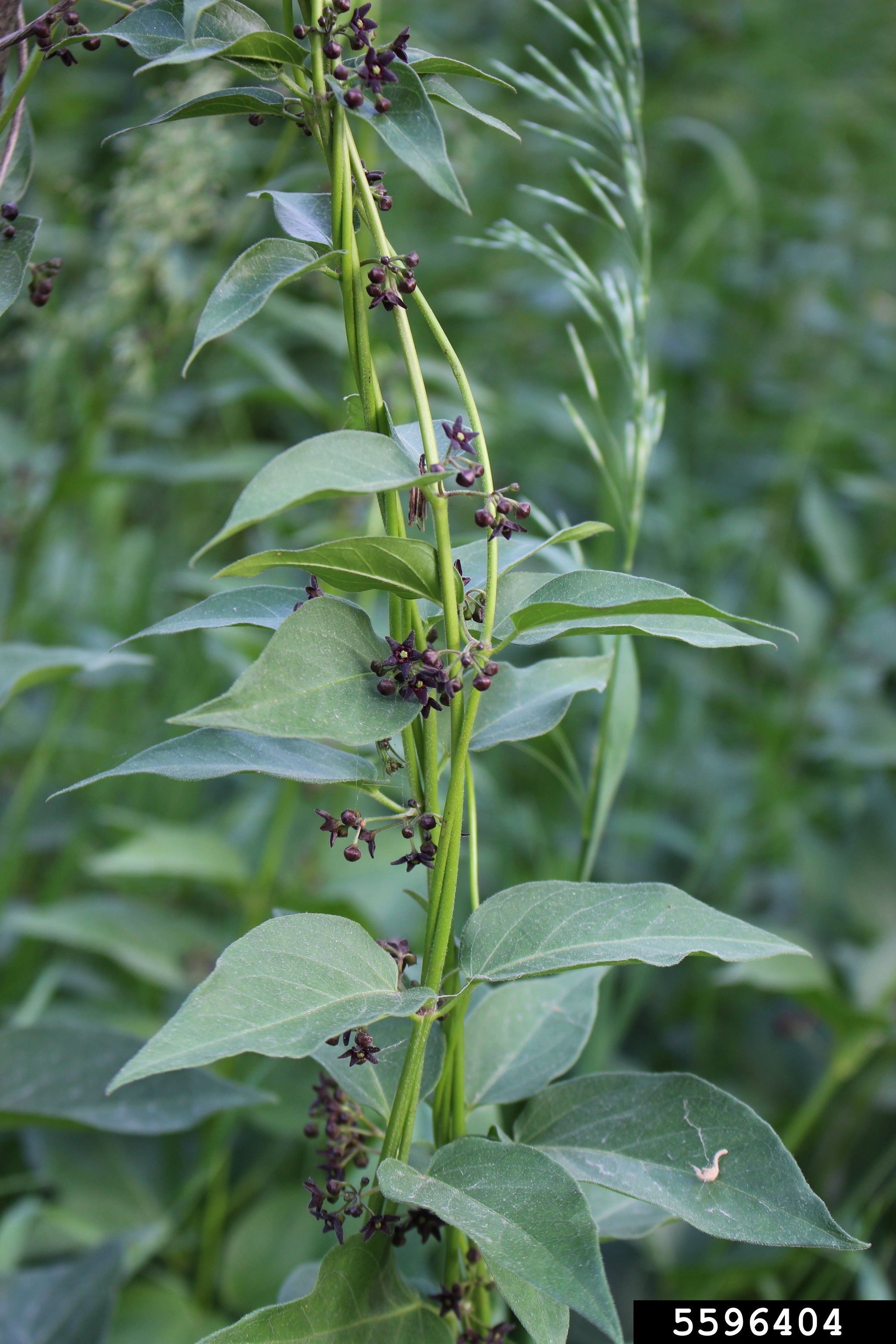
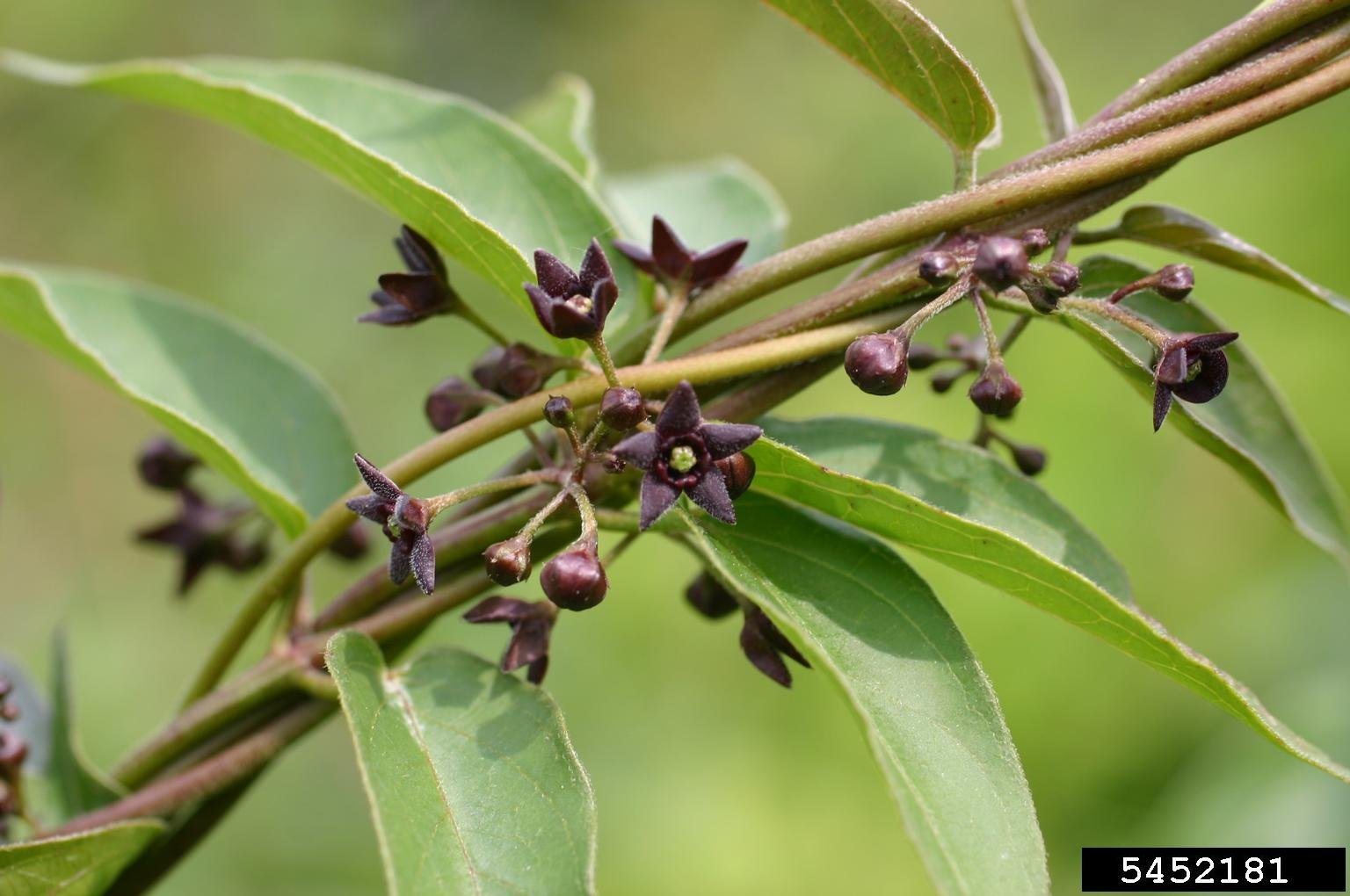

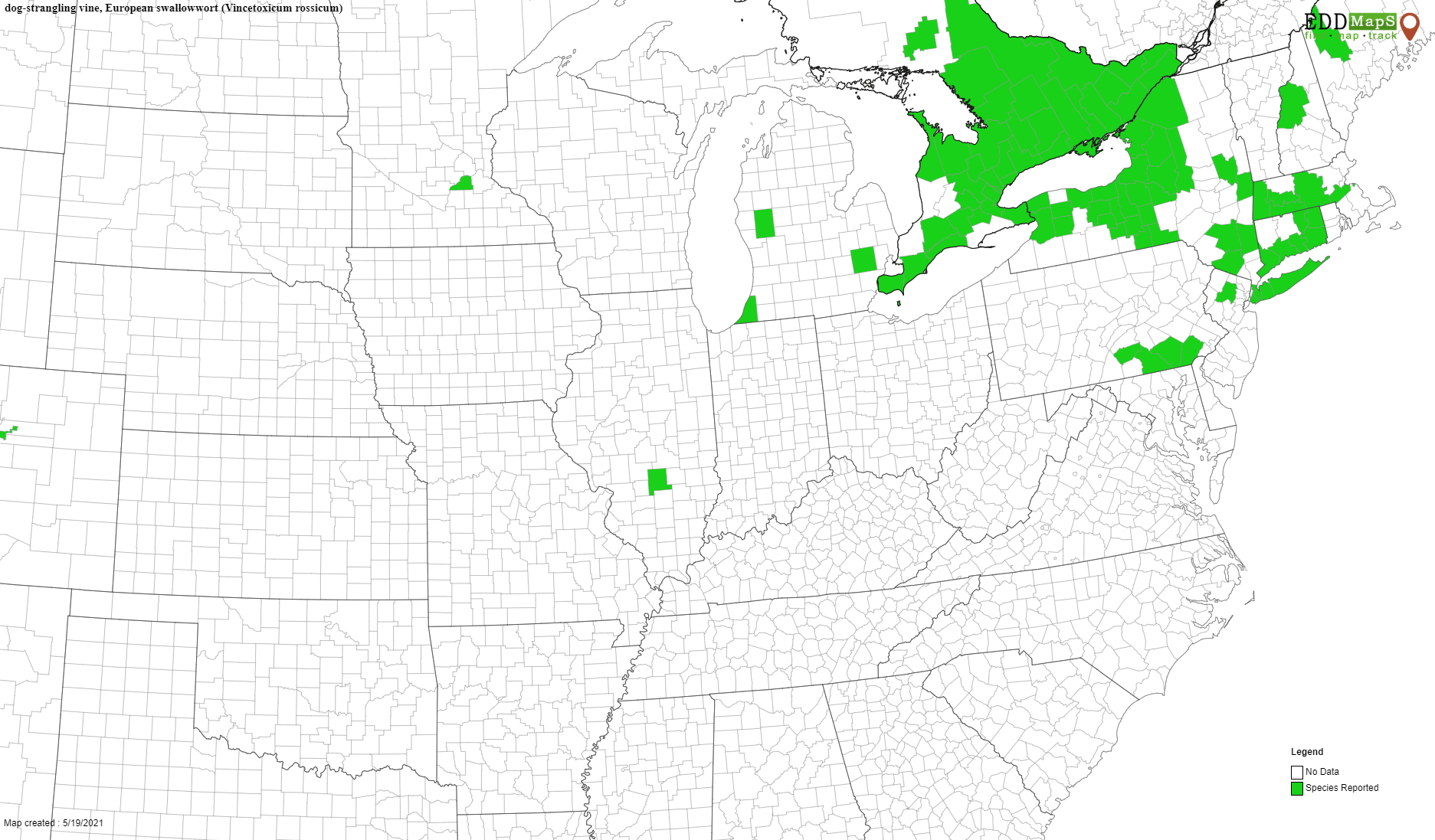

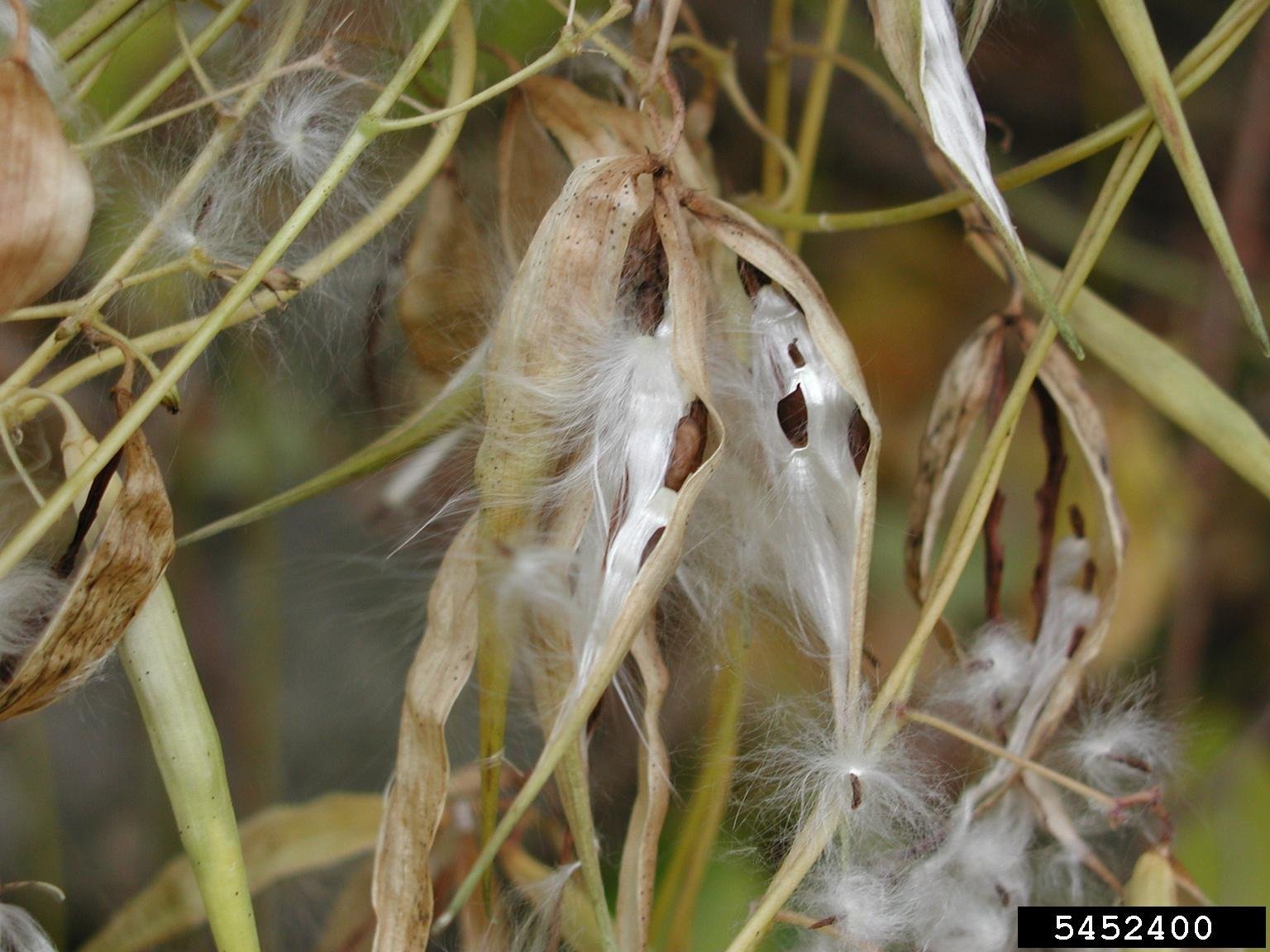
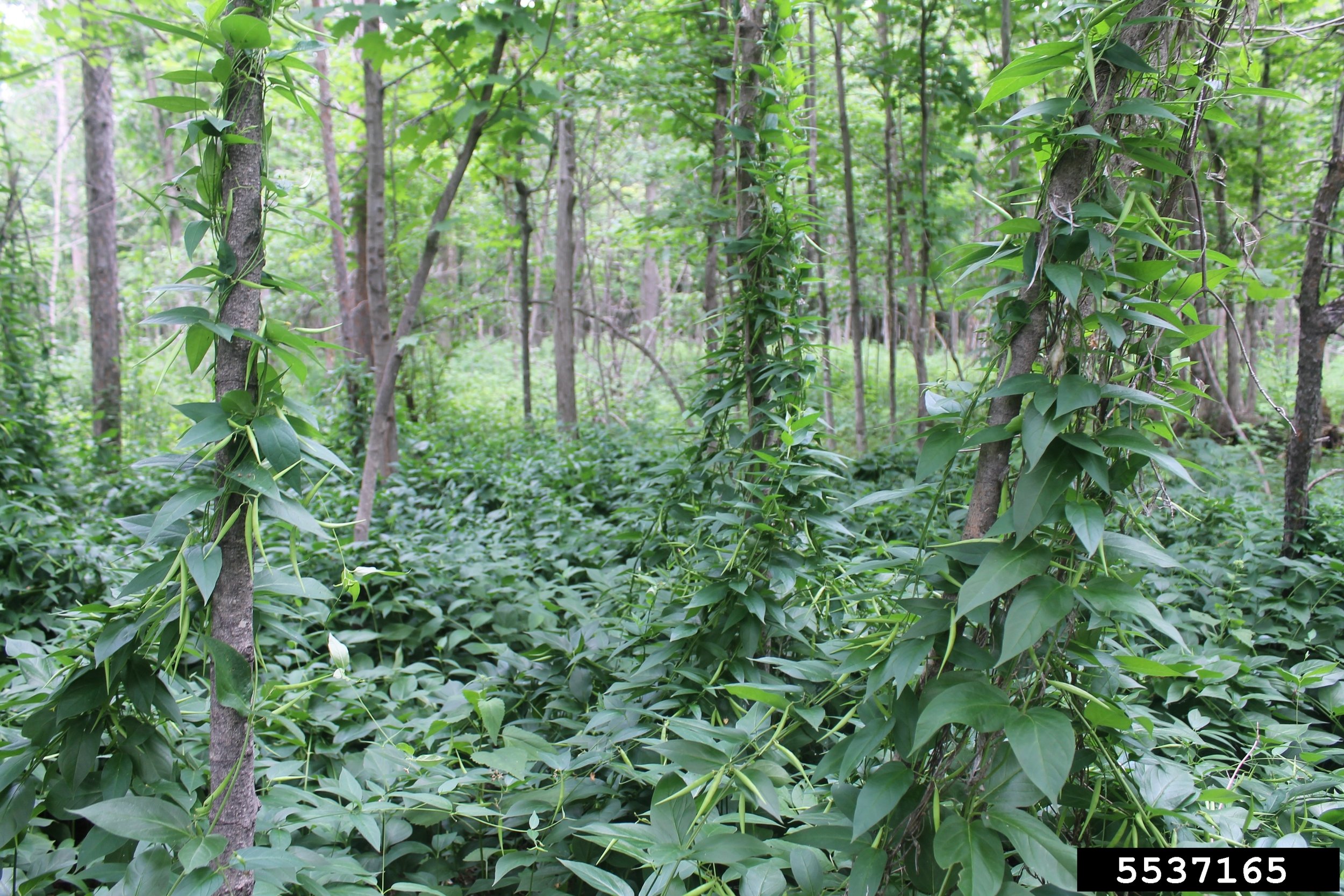
LOOK-A-LIKES: The black and pale swallow-worts may be confused with honeyvine (Cynanchum laeve, also called sandvine, bluevine milkweed, and smooth swallow-wort), a native perennial herbaceous vine growing in habitats similar to those where swallow-worts are commonly found. It has a similar twining vine growth habit and opposite, heart-shaped leaves. The flower has five petals, as do the swallow-worts, but the petals are white or sometimes white, tipped with pink. Honeyvine produces the milkweed-like seed pod and flat seeds with attached downy hairs, similar to the swallow-worts. Other possible look-a-likes include our native milkweeds (Aesclepias), which are in the same family as swallow-worts (Apocynaceae). Milkweed species often have opposite leaf arrangement and similar-looking fruit pods and seeds, but are upright herbaceous plants, not vines, and have a milky sap, as opposed to the clear sap of the swallow-worts. Bindweeds (Convolvulus) and morning glories (Ipomoea) are herbaceous twining vines like swallow-wort, but have alternate leaf arrangement and large, showy horn or funnel-shaped flowers.
HABITAT & DISTRIBUTION: Swallow-worts thrive in a wide range of growing conditions, soil types and soil pH. They are shade-tolerant and thrive best growing in full sun to partial shade. Heavy shade was found to greatly reduce swallow-wort seedling survival; partial shade did not. They are most commonly found growing in disturbed environments such as roadsides, old fields, pastures, forest edges, and similar habitats. Black swallow-wort is currently the most widely distributed of the two species in North America and occurs in Northeastern and Upper Midwest states and Ontario, including relatively small populations in scattered counties in central and northern Indiana. As of the writing of this, pale swallow-wort occurs primarily in Northeastern states, Michigan and southern Canada. Populations are found in Michigan counties bordering northern Indiana, but none have been reported for Indiana. It’s likely that the swallow-worts are more widely distributed than currently reported on EDDMapS online invasive species geodatabase reporting system.
ECOLOGICAL THREAT: Swallow-wort is highly invasive. Because of its rapid growth and abundant viable seed production, swallow-wort vines quickly twine around and climb neighboring plants, overwhelming them by physically shading them, weighing them down, causing stem breakage, and competing for moisture and nutrients. After years of unchecked growth and spread it can cover large areas with a dense, tangled thicket where little else can live. It invades fields, fence rows, woodland edges and even shaded forest environments. It threatens pollinator habitat and rare plant communities such as glades, fens, prairie remnants and savannahs. Forest regeneration and conservation tree plantings may also be harmed. Swallow-wort can invade pastures and can be toxic to livestock if consumed in large enough quantities. There is evidence that swallow-wort produces an allelopathic effect, secreting a chemical into the soil that inhibits the growth of neighboring plants. They also produce chemicals that are distasteful to many insects and even toxic to some, including monarch butterfly larvae.
CONTROL: Since the swallow-worts are not yet well established in Indiana, greater effort should be made to increase awareness of them among land/natural resource managers and landowners. Informed resource managers and landowners can assist in identifying new populations so we can more accurately determine their distribution and map their occurrences. For well-established populations and the management of lands and natural resources near them, a management plan should be developed based on the following principles: 1) Prevention of spread; 2) Early detection of and rapid response to new populations; and 3) Properly timed and targeted control measures that consider long-term effectiveness, impact on non-target or desirable species, soil/site disturbance, cost, and available labor and equipment.
Herbicide, applied as a foliar spray, is the most practical, effective, and economical means of controlling swallow-wort. Spraying should be done around the time that flowering begins and small seedpods start developing. A single herbicide application will likely not provide complete eradication of swallow-wort. The site should be monitored to determine treatment effectiveness and to identify individuals that were missed or otherwise survived. A follow-up spraying should be done later in the summer. Triclopyr and glyphosate are both effective at controlling established swallow-wort plants. Triclopyr is a broadleaf-specific herbicide and applied at proper rates will not harm grasses and sedges. Glyphosate is a broad-spectrum herbicide and will damage all classes of plants. On degraded sites lacking high-quality plant communities, glyphosate is the cost-effective choice. Where desirable grasses and other monocot plants occur, triclopyr provides more selective control. A non-ionic surfactant or seed oil adjuvant should be used to increase herbicide uptake. For more detailed information on management and control of swallow-wort see Purdue Cooperative Extension Service publication, FNR-620-W, Invasive plant series: swallow-worts (link listed below).
To report an invasive species location:
Early Detection and Distribution Mapping System (EDDMapS): https://www.eddmaps.org/report/
ADDITIONAL INFORMATION:
https://www.extension.purdue.edu/extmedia/FNR/FNR-620-W.pdf
https://www.inaturalist.org/taxa/208963-Vincetoxicum-nigrum
https://mnfi.anr.msu.edu/invasive-species/Swallow-wortBCP.pdf
https://www.invasive.org/browse/subinfo.cfm?sub=3398
https://www.invasive.org/browse/subinfo.cfm?sub=4260
https://www.in.gov/dnr/rules-and-regulations/invasive-species/terrestrial-invasive-species-plants/
IMAGE CREDITS:
Black Swallow-wort opposite leaves and flowers, photo by Emma Erler, University of New Hampshire, Bugwood.org
Black Swallow-wort twining, “rope-like” vines and flowers, photo by Leslie J. Mehrhoff, University of Connecticut, Bugwood.org
Pale swallow-wort flowers, photo by Rob Routledge, Sault College, Bugwood.org
Swallow-wort fruits, photo by Leslie J. Mehrhoff, University of Connecticut, Bugwood.org
Dry swallow-wort fruits and seeds, photo by Leslie J. Mehrhoff, University of Connecticut, Bugwood.org
Swallow-wort infestation, photo by David Nisbet, Invasive Species Centre, Bugwood.org
Black swallow-wort distribution map courtesy of EDDMapS. 2021. Early Detection & Distribution Mapping System. The University of Georgia -Center for Invasive Species and Ecosystem Health. Available online at https://www.eddmaps.org/distribution/uscounty.cfm?sub=3398
Pale swallow-wort distribution map courtesy of EDDMapS. 2021. Early Detection & Distribution Mapping System. The University of Georgia -Center for Invasive Species and Ecosystem Health. Available online at https://www.eddmaps.org/distribution/uscounty.cfm?sub=4260
REFERENCES:
Anon. Invasive species alert: black swallow-wort (Cynanchum louisea) and pale swallow-wort Cynanchum rossicum). Monarch Joint Venture. www.monarchjointventure.org 2 p.
Anon. 2012. Black and pale swallow-worts. Invasive Species – Best Control Practices series. Michigan Dept. of Natural Resources, Michigan Natural Feature Inventory. 7p.
Averill, K.M., A. DiTommaso, and S.H. Morris. 2008. Response of pale swallow-wort (Vincetoxicum rossicum) to triclopyr application and clipping. Invasive Plant Science and Management 2008 1:196-206.
Douglass, C.H., L.A. Weston, and A. DiTommaso. 2009. Chapter 13, Black and pale swallow-wort (Vincetoxicum nigrum and V. rossicum): The biology and ecology of two perennial, exotic and invasive vines. Pp. 261-277. In: Inderjit ed. Vol. 5. Management of Invasive Weeds, 363 p. In: J.A. Drake ed. Invading Nature – Springer Series in Invasion Ecology. Springer Science, Dordrecht, Netherlands.
Magidow, L.C., A DiTommaso, Q. Ketterings, C.L. Mohler, and L.R. Milbrath. 2013. Emergence and performance of two invasive swallowworts (Vincetoxicum spp.) in contrasting soil types and soil pH. Invasive Plant Science and Management 2013 6:281-291.
McKague, C.I. and N. Cappuccino. 2005. Response of pale swallow-wort, Vincetoxicum rossicum, following aboveground tissue loss: implications for the timing of mechanical control. Canadian Field-Naturalist 119(4):525-531.
Mervosh, T.L. and D. Gumbart. 2015. Cutting and herbicide treatments for control of Oriental bittersweet, pale swallow-wort and Morrow’s honeysuckle. Natural Areas Journal 35(2):256-265.
Milbrath, L.R. A.S. Davis, and J Biazzo. 2017. Demography of invasive black and pale swallow-wort populations in New York. Northeast Naturalist 24(1):37-53.